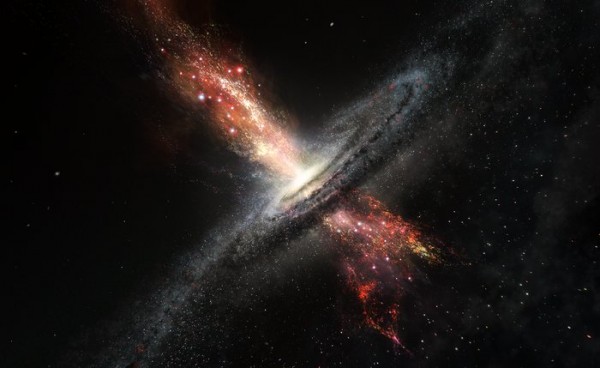By Ana Verayo, | March 29, 2017

Artist’s impression of a galaxy forming stars within powerful outflows of material blasted out from supermassive black holes at its core.
In a new discovery, scientists were able to identify supermassive black holes that have been ejecting energetic stellar material outflows due to new stars being born. This discovery also marks the first time that scientists were able to detect evidence of star formation in such extreme cosmic environments.
Like Us on Facebook
With this new finding, this can also help astronomers to further understand how galaxies form into distinct shapes, or how the universe is filled with heavy elements, including the source of dark matter and cosmic infrared background radiation.
With the help of the European Southern Observatory's Very Large Telescope (VLT), astronomers from the University of Cambridge conducted a new study and identified a massive galactic collision known as IRAS F23128-5919 that is located some 600 million light years away.
Most galaxies are host to a supermassive black hole in their centers. This means that those near the black hole such as cosmic gas, dust and everything that surround it will be heated up to incredible scorching temperatures in the form of dense and powerful cosmic winds.
In this new study, scientists observed and examined these galactic blasts of energies that are escaping from the supermassive black hole that is located in the galactic collision's southern galaxy. Their results revealed that with those powerful ejections, stars can begin to form.
According to lead author of the study, Roberto Maiolino from the University of Cambridge, astronomers have always thought that these outflows from supermassive black holes can create the right conditions for star formation but this is the first time that we are seeing it happen and this has been a very difficult observation. In short, within this powerful bursts of energies, stars are being created.
Thanks to the VLT's spectroscopic instruments, MUSE (Multi Unit Spectroscopic Explorer) and the X-shooter, scientists were able to identify these newly formed stars within the material outflows from the supermassive black hole.
Using the X-shooter, the team was able to identify what causes nearby gas clouds to glow, due to the radiation emitted by the black hole. Within the material outflow, an infant stellar population was detected that are just around a few tens of millions years old which are brighter and hotter than regular stars.
Scientists were also able to detect the motion and velocity of these infant stars where the light from this region indicates that they are travelling so fast and away from the center of the galaxy. This is typical of cosmic objects that are blasted off by black holes due to a stream of powerful energy outflows.
This new study is published in the journal, Nature.
-
Use of Coronavirus Pandemic Drones Raises Privacy Concerns: Drones Spread Fear, Local Officials Say

-
Coronavirus Hampers The Delivery Of Lockheed Martin F-35 Stealth Fighters For 2020

-
Instagram Speeds Up Plans to Add Account Memorialization Feature Due to COVID-19 Deaths

-
NASA: Perseverance Plans to Bring 'Mars Rock' to Earth in 2031

-
600 Dead And 3,000 In The Hospital as Iranians Believed Drinking High-Concentrations of Alcohol Can Cure The Coronavirus

-
600 Dead And 3,000 In The Hospital as Iranians Believed Drinking High-Concentrations of Alcohol Can Cure The Coronavirus

-
COVID-19: Doctors, Nurses Use Virtual Reality to Learn New Skills in Treating Coronavirus Patients







